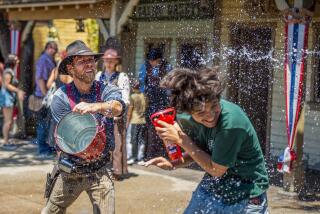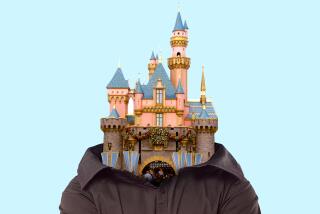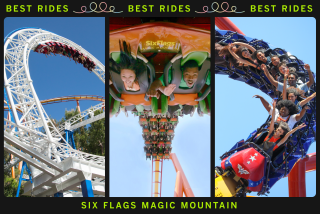U.S. From Abroad : In Britain, the U.S.A. Is A-OK : And nowhere is it cooler to be American than at American Adventure, a theme park that celebrates all that is bold and brash in ‘the Colonies.’
ILKESTON, England — A Mississippi steamboat pulls up to the dock at “Frisco Wharf,” just across from a sign boldly advertising a local specialty--clams.
Looming in the distance is “Mt. Rushmore,” where the sculpted faces of prominent Indians line the side of an ersatz mountain. Afternoon tea is available at a cozy spot near the “Alamo.”
This is America--British-style.
More than 750,000 people, mostly Britons, will pass through the star-spangled gates of the American Adventure theme park this year, ready to experience the exotic ways of a distant land.
Theme parks are, by nature, places that rely on stereotyped images to draw and amuse visitors. France becomes the Eiffel Tower, sidewalk cafes and tilted berets--despite French society being far more diverse than that. England becomes Big Ben, castles and brollies.
In theme park dimensions, then, American Adventure reflects a British vision of a U.S.A. that is bold, brash, creative and technologically advanced. The wholesome aspects of the American myth are on display--cowboys, World War II-era GIs and astronauts.
Missing is the dark and menacing image of America that is embellished regularly in Britain by apocalyptic news stories and Arnold Schwarzenegger blockbusters about random violence and muscle-bound vigilantes.
That side of America is well known in Britain, too. But not here, not today.
Each section of the park, located 120 miles north of London, is designed to replicate a different region of the United States.
Patrons, many wearing either cowboy hats or Indian war paint, ride The Missile roller coaster at Spaceport, U.S.A. They wander the Wild West town of Silver City, listen to Dixieland jazz, prowl the wooden ramparts of Fort St. Lawrence, stroll through a New England village and ride the Santa Fe railway.
“We have the pick of everything above and below the Mason-Dixon Line,” the park boasts. “It’s an American state of excitement all day long.”
Even the coin-operated amusements scattered around the grounds have an American flavor. In one, the legend of the U.S. trucker is evoked as participants use a remote-control device to hook up a toy-size truck cab to its trailer. In a similar game, players “drive” an antique pickup loaded with moonshine while trying to evade a fleet of old-time police cars and, inexplicably, firetrucks.
American music fills the air. Mostly its Glen Campbell, Neil Diamond and some generic country-and-Western band. But at a store offering cowboy boots, silver belt buckles and other Western paraphernalia, shoppers browse to Motown hits. And at a basketball-toss stand, would-be Magic Johnsons attempt five-footers to the sound of a string quartet playing somber classical pieces.
Now in its fourth season, American Adventure is an unqualified success. The number of visitors it attracts is considered high by British standards, and patrons are spending their pounds and pence freely in the park’s restaurants and shops.
Stores such as “All That Jazz” are stocked with footballs, six-shooters and Dodger caps. The restaurants, despite ultra-American sounding names like the Trading Post and the New England Saloon, never actually stray too far from British staples like fish and chips.
There is no shortage of diners in a restaurant called Capone’s, which is decorated with pictures of cowboys, Elvis, Marilyn Monroe and Mickey Mouse--but not one hint of Al Capone.
Is it really a fascination with America that has lured the crowds to this place? Is there something about the United States that gets people to queue up for a ride on the High Sierra Wagon Ride, a ferris wheel of circling covered wagons?
Is it considered cool to be American?
Cooler, apparently, than to be British.
American Adventure rose from the ashes of a failed theme park that had been designed to showcase all that is great about Britain. The centerpiece of that park, according to an English Tourist Board report on the project, was an area “dedicated to the theme of British genius--a dynamic, showcase exhibition reflecting the British genius for invention and enterprise and also Britain’s contribution to the development of the modern world.”
Britannia Park, as it was called, was a disaster, and it folded in nine weeks.
“They lost a heck of a lot of money,” says Helen McMillan, public relations coordinator for American Adventure.
The reasons for Britannia Park’s failure were varied. But McMillan, who was not connected with the operation, believes that a major cause was the lack of excitement generated by the British theme. “We all know about the Industrial Revolution,” she says. “We were all taught it in school.”
Soon after the closure, a company called Park Hall Leisure (which has since been sold to the giant Granada Group Plc.) built American Adventure on the site. It was an instant hit.
“America is perceived as being very glamorous,” explains McMillan. “So many of the movies and television programs we have here are American. It’s very seldom that you see a movie that is British-made--or even European-made for that matter. All movies are glamorous; therefore, we perceive America as being glamorous.”
And even with the abundance of American entertainment, the United States is still something of an unknown, says McMillan. “We’re all intrigued by it. There’s something interesting and exciting about it.”
Park visitors get very caught up in the theme, she says. “They get their faces painted, they buy hats, they buy guns for their kids. We really like to say we are selling an experience, if you like.”
American Adventure’s northern location, in the working-class East Midlands region, is a major factor in the type--and possibly the number--of visitors the park attracts. The southeast of England, which includes London, is the most affluent. The north, by contrast, is struggling. And it is from this northern pool of Britons--the 17 million people who live within a two-hour drive of the park--that American Adventure draws its visitors.
For most of them, American Adventure is as close as they’ll ever get to seeing the United States.
“The people in this area are less likely to have traveled to the States,” says McMillan. “So they perhaps come here and go ‘Oh, yes. It’s like going to America.’ ”
But if the parks’ patrons go there because they are intrigued by America, they certainly aren’t admitting it to an American reporter.
“It’s just a day out,” says Graham Hickman of Manchester, catching the view from atop Mt. Rushmore. “I don’t think America really comes into it.”
“The price is good,” adds his friend, Joanne Tait.
Dave Hibbert of Birmingham, who came with his children, said his visit had nothing to do with the American theme. “Nothing against America either, mind you,” he adds. “It’s just a nice place to go--and we had half-price tickets.”
At Lazy Lil’s Saloon, a crowd is waiting for the stage show to begin. Pauline Stephenson sits at a table with a beer, dressed in war paint and Indian headband. Stephenson, the landlady of a pub called the Engineers Arms in the town of Hull, is with a group of 160 pub regulars on a day trip to the park.
Was it proximity or the American theme that interested her group?
“It’s a bit of both, I would think,” she says. “Everybody’s got a bit of cowboy in them, don’t they?”
More to Read
Sign up for The Wild
We’ll help you find the best places to hike, bike and run, as well as the perfect silent spots for meditation and yoga.
You may occasionally receive promotional content from the Los Angeles Times.






